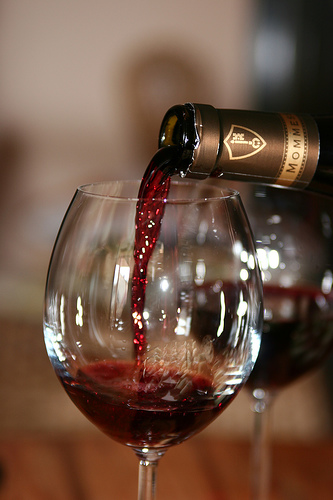Purple teeth and lips may bring a knowing grin to regular wine drinkers but your dentist won’t consider it something to smile about.
Acid is a tooth’s biggest foe but simple strategies for regular and occasional wine drinkers can protect enamel and prolong the life of a toothy smile. “Acid breaks down the enamel on the teeth, so essentially it can cause them to become more porous,” said Dr. Dan Marut, D.M.D., a dentist based in Medford, OR. “Of course if you drink wine you’re not going to see holes on your teeth; it sets your teeth up to collect stain. That can be acid from wine or something like lemon juice.”
Marut is a nationally-known spokesperson on all matters dental. He’s probably best known as the founder of dental care provider Quality Dental Plan and of NewDocs.com (think of it as privatized Facebook for dentists). Here he breaks down the mouth’s chemistry to explain why Petit Verdot is turning mouths purple.
“Red wine and white wine have different acidity levels,” he started. “’The red wine has, because it is red, staining components. lt etches the teeth and creates a more porous structure for red wine color. The chromogen [coloring agent] is going to go ahead and stain your teeth while you’re drinking that wine. Essentially with white wines, that [acid] is etching the teeth as well but white doesn’t have that staining component in it. If you’re drinking white wine and then eating something with stain in it afterwards, that stain is being collected in that etched tooth structure.”
Marut’s advice may not be new but it’s often ignored, he believes. He says the most common mistake is to run for the toothbrush. According to Marut, brushing right afier wine consumption can cause more damage than good. “Your teeth have been directly affected by acid. You don’t want to go ahead and use an abrasive toothpaste on those teeth directly afterwards. The reason we always suggest waiting an hour is because your saliva has benefits for your teeth. The saliva will help to re-mineralize those areas which is helpful because it will help decrease the breakdown.”
And just like any trip to the dentist’s office, you don’t get out of the chair until the dentist talks about flossing. “Brushing harder doesn’t help; it’s flossing that is sometimes a neglected part of removing stain from teeth. When we’re smaller everyone is taught ‘brush, brush, brush’ but for some reason the flossing habit doesn’t sink in as well. In between the teeth is where the stain usually forms first.”
If you’re a long time wine, coffee, or tea drinker and want whiter teeth, Marut’s advice will have a familiar feel. Start off with a cleaning at your dentist’s office and use American Dental Association-approved products while under the care of your family dentist. Marut said he wasn’t familiar with some of the newer stain-removing products marketed to wine drinkers. He couldn’t and wouldn’t discredit the products but added “rinsing and brushing later is effective and cost effective.”
Marut’s dental membership plan provides free teeth whitening for patients. He said that offer can be motivation to get people into a dentist’s office where they will learn more about maintaining a healthy mouth whether it’s wine or something else causing the stains. In the mean time, to help avoid tooth staining, wait an hour after drinking wine, then be sure to brush … and floss.
 Howard W. Hewitt is a former career journalist who writes a bi-weekly newspaper column in Indiana. he also writes about value wine on his blog, Grape Sense – A Glass Half Full.
Howard W. Hewitt is a former career journalist who writes a bi-weekly newspaper column in Indiana. he also writes about value wine on his blog, Grape Sense – A Glass Half Full.


